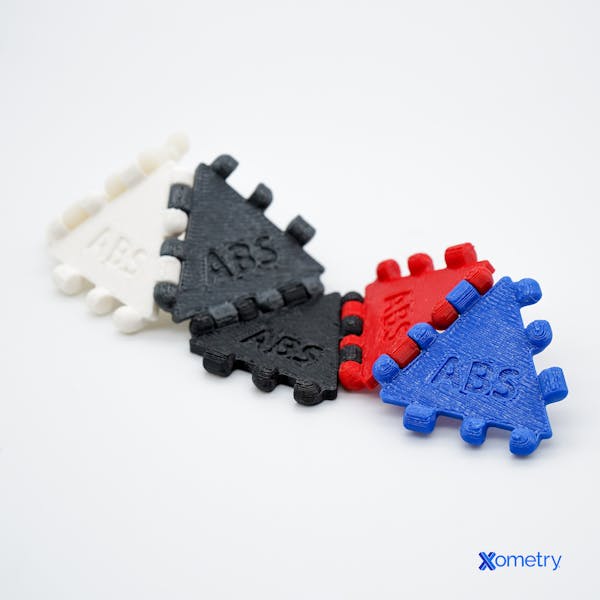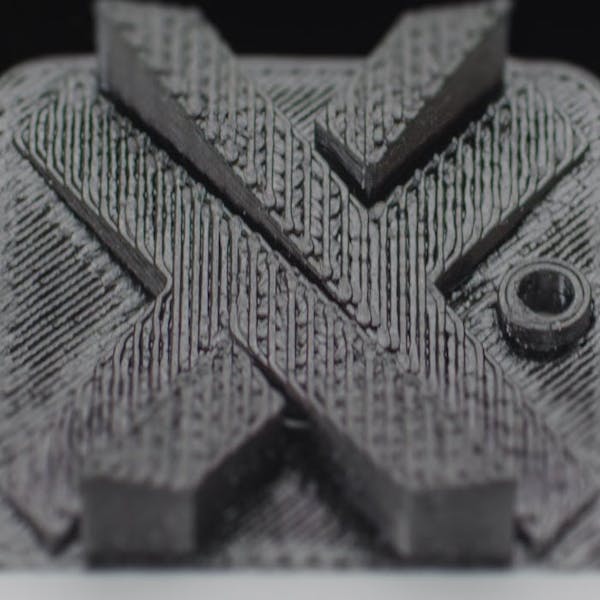ABS is a well-known manufacturing material and a staple in many industries. You can find it in everything from toys and home appliances to car parts. It’s even helpful in 3D printing and prototyping applications. But what is it made from, and does it have any drawbacks? Let’s find out.
What is ABS?
ABS stands for acrylonitrile butadiene styrene, and it’s a non-transparent thermoplastic and amorphous polymer that’s made by mixing together two plastics and one rubber. Depending on the ratio of the blend, the properties will differ. Here are the three monomers used to make ABS:
- Acrylonitrile: A synthetic monomer that’s made by bonding propylene and ammonia together, which gives ABS rigidity and resistance to heat. As more acrylonitrile is added to ABS, the part will start sacrificing some of its elasticity.
- Butadiene: A synthetic rubber monomer that’s made by removing hydrogens from petroleum-based compounds, which in turn creates stronger, more unsaturated hydrocarbon chains. If a lot of this is added to ABS, the part will become softer, more pliable, and less brittle.
- Styrene: Created using a similar process to butadiene, this usually takes up around 50% of the ABS composition, with the other two varying in amounts. It’s not that common to find styrene in quantities much over 50% in this mix because, although rigidity can increase, resistance to heat goes down as more is added.
The image below shows an example of some parts made from ABS:

ABS can be found almost everywhere, including LEGO bricks, computer keyboards, housings for power tools, wall socket guards, vehicle interiors, corrugated construction sheets and tubing, and even hard hats. It’s favored among many other materials because it’s relatively cheap and comes in vibrant colors, too. It can also be painted or glued quite easily and has the potential of reaching very glossy finishes. Here are a few more of its perks:
- Available in various forms, including pellets, tubes, bars, and filaments
- Is lightweight, strong, and sturdy
- Easy to machine
- Reasonably priced
- Resistant to chemicals, heat, impact, and abrasion
- Is fully recyclable because it can withstand lots of heating and cooling cycles
- Low heat and electrical conductivity
Some potential drawbacks for some, though, include that this material has a bit of a low melting point, especially when compared to other plastics, so it’s not the best choice for very hot situations. Its resistance to things like UV light, solvents, and fatigue stress is also quite bad. When heated, ABS can produce terrible fumes or smoke, which can ultimately be very dangerous to inhale. Also, if it’s not recycled properly, it can produce bad waste that is not biodegradable, and if it’s used in an environment with high friction, it can degrade really quickly.
How it’s Made
It usually comes down to an emulsification process, during which incompatible materials are blended together to make a uniform mixture—somewhat similar to how milk stays mixed, and the fats, oil, and water remain together. Other processes can also be used, like continuous mass polymerization, which is a patented method, but it’s still not as standardized as emulsification. During the process, acrylonitrile bonds the polymer chains of styrene and butadiene, providing a strong and versatile plastic overall. That’s one of the reasons ABS is so popular in 3D printing, CNC machining, and so many other processes. When compared to other prominent additive manufacturing materials, ABS tends to be better at retaining color variety, strength, and other qualities needed. It’s also great for rapid functional prototyping. The image below is an example of a Xometry logo made using ABS:

Frequently Asked Questions on ABS
Is it toxic?
In its final form, it’s usually fine. It’s even used in food processing. The only danger is what we mentioned earlier about it being heated up during processes like 3D printing or injection molding. Studies have shown that these emissions are usually linked to cytotoxicity, oxidative stress, and inflammation, so maybe stay away from those fumes, or at the very least, use a fume hood. Interestingly, ABS isn’t currently approved for medical implants. Experts have said that there could be potential negative long-term effects—although no one has clarified what these are exactly.
What are the environmental impacts of ABS?
If it’s not properly recycled, the sad news is that it contributes to plastic pollution. However, as we mentioned, it can be recycled, but many ABS products still somehow end up in landfills, where they stick around for decades. Another downside is that during the process of making ABS, petroleum-based materials are used, and ultimately this contributes to carbon emissions. We hope advancements will be made to make ABS even more environmentally friendly, but as of right now, it’s a little hit-and-miss.
Can it be used outdoors?
Yes and no. It’s resistant to impact and is very durable, which are qualities that everyone appreciates when it comes to exterior features. But, we already mentioned that ABS is not great when it comes to UV resistance, so if it’s used outside in the sun for a long time, it will likely lose its color and crack. You can use certain coatings to alleviate this, but ultimately, if you want a good outdoor substance, it might be a good idea to use another material like polycarbonate or acrylic.
How Xometry Can Help
Producing plastic parts is more than possible at Xometry, and we have a long list of manufacturing services you can get instant quotes for depending on your needs, including plastic injection molding and customized services like thermoforming. Take a look at our plastic 3D printing, plastic extrusion, and plastic laser cutting pages for more information.
Disclaimer
The content appearing on this webpage is for informational purposes only. Xometry makes no representation or warranty of any kind, be it expressed or implied, as to the accuracy, completeness, or validity of the information. Any performance parameters, geometric tolerances, specific design features, quality and types of materials, or processes should not be inferred to represent what will be delivered by third-party suppliers or manufacturers through Xometry’s network. Buyers seeking quotes for parts are responsible for defining the specific requirements for those parts. Please refer to our terms and conditions for more information.


